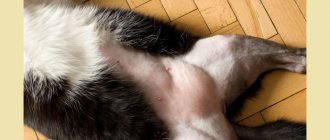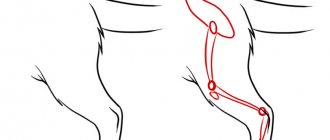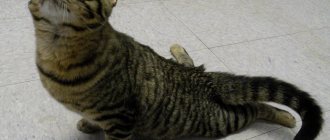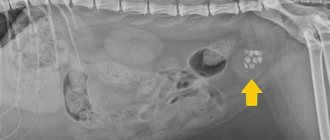When our pet is sick, it’s scary. But when is it paralysis in cats – doubly scary and this is a real test for both the owner and the pet itself. The cat’s paws give out and the owner immediately has many questions: why is this, who is to blame, what should be done and how should the pet continue to live? Many veterinarians shrug their shoulders and say that it is easier to euthanize the animal so as not to torture them.
Our veterinarians are confident that paralysis of the hind legs is not a death sentence.
! Yes, it is often quite difficult to fully recover, but it is still possible. The main thing is to follow the instructions and prescriptions of your doctor.
Transporting a cat in such a situation can be dangerous, so we recommend using our home call service. An experienced YA-VET veterinarian, working according to European standards, will certainly tell you what to do next and help you.
Possible reasons
There are many reasons why a pet's hind legs fail. It is quite difficult to identify them, so you need to remember everything that your pet has interacted with recently. What did you eat, where did you go, etc.
. Even a seemingly harmless ear mite can cause such a terrible disease.
In this article we will present only those common reasons why paralysis may occur . There are quite a lot of them, so under no circumstances do the diagnosis yourself; entrust it to a professional who has already encountered the disease and knows what to do and how to restore a full life to your pet.
Spinal injuries
The most obvious and common is a dislocation, a fracture of the cat's spinal cord. Most paralysis is sudden, hollow and bilateral. In such an unfavorable situation, symptoms appear almost immediately. In case of serious injury and bruise, it may be accompanied by painful shock and loss of consciousness. Unfortunately, it is very rarely possible to fully recover from this.
Spinal cord inflammation
Due to poisoning, toxins in the body, or some kind of infection, the cat may lose its hind legs. This is also accompanied by incontinence, increased temperature, fever, etc. If you follow the doctor’s instructions, recovery is more than possible, and the prognosis is most often favorable.
Thromboembolism
Occurs due to impaired blood supply. Due to blockage of blood vessels by blood clots (a piece of tumor or a parasite), tissue death occurs. Because of this, the cat screams in pain, shock, decreased blood pressure and heart rate, respiratory rate, and increased temperature. The disease develops gradually and what is important here is how quickly the owner responded to the symptoms and how quickly he called the veterinarian.
Stroke
Symptoms and signs include fainting, shock, confusion about where the cat is, lethargy and apathy. Along with the paws, there may be paralysis of the pharynx, which causes choking and difficulty in eating food and swallowing in general. When a cat's hind legs fail after a stroke, the prognosis is favorable and the likelihood of improvement is high.
Fibrocartilaginous embolism
In other words, this is tissue death. It is most often caused by blockage and disruption of the blood vessels of the cat’s spinal cord. The disease develops at lightning speed, begins with the cat screaming in pain, followed by laziness, apathy, lack of playfulness, reluctance to walk, react to other stimuli from the owner, reluctance to eat, after which comes the final stage, when the paws finally die. Here everything is more complicated and the prognosis can be both favorable and not.
Tick paralysis
Ticks are a big problem for both people and animals. Their poison and toxins kill the body from the inside within a few days. It is very important to consider the symptoms and stages, because the prognosis depends on them. At the beginning, the symptoms are invisible to the eye: pet agitation, anxiety and stress. After some time, apathy begins, a reluctance to move and go somewhere, playfulness disappears. Then the pet begins to feel poisoned in the body, he feels sick, he trembles, his temperature drops, his pulse decreases and his breathing shortens. At the last stage, paralysis of the hind legs and more already occurs. Paralysis may also occur in the larynx. Recovery is possible, but only in the first 2-3 stages, and not in the last, when the entire body of the animal is poisoned.
Cardiomyopathy
The volume of the ventricles in the heart decreases, the walls become denser. Because of this, activity deteriorates, appetite decreases, and complete apathy to surrounding stimuli. Attacks of vomiting and coughing also appear. Here it just seems like paralysis is piercing your paws. In fact, with such a disease, paralysis itself does not often develop. If they are completely eliminated, then there is a layering with other reasons, for example, thromboembolism or other blockages of any vessels in the cat’s body. If only cardiomyopathy occurs, then the prognosis for recovery is good.
Hernia
With a herniated spine, the cat refuses to move. Any touch to an animal brings pain. If a cat walks, it bends strongly, its head is lowered down. Most often, after surgery, the pet recovers quite quickly and asymptomatically.
The cat's hind legs gave out
Fluffy pets are usually very active. They constantly run around the house and play with their owners. But sometimes they get sick and become lethargic and quiet. A sick cat may lie in its sleeping area all day and refuse to eat.
Have you noticed that your cat has started dragging one or both hind legs? Or did her gait become unsteady or her limbs become sore? These are all neurological symptoms of paralysis or paresis of an animal’s paws, which, with similar manifestations, can be caused by different reasons. Therefore, it is very important to show your pet to veterinary clinic specialists in a timely manner so that they can establish the correct diagnosis and begin treatment immediately. Only early treatment will help stop the disease and return the cat to the former mobility of its paws. If you notice something is wrong, take a closer look at your pet's behavior. You may notice the following signs of hind limb movement disorders:
- wobbling gait affecting the hind legs;
- uncertainty of gait - the animal walks slowly and unsteadily, as if it has lost its sense of balance;
- the hind legs begin to move apart, and after a few months they may completely fail;
- the cat often squats on its hind legs (usually if the animal is over 10 years old);
- the animal drags its paws without lifting them from the floor;
- general mobility decreases, gait is impaired.
Each of these symptoms should alert the cat owner - after all, these manifestations signal a problem with the pet’s nervous system. Therefore, lost time only aggravates his condition. What are the reasons for paw failure? Damage to the lumbar spine Such damage can occur as a result of an animal falling from a height. The myth that a cat groups itself when falling and always falls on its paws is not always confirmed by real-life cases. Veterinarians often have to treat Muroks that have fallen from windows and balconies, or fallen from a roof or tree. The injured lumbar spine is responsible for the functioning of the hind legs, tail and, partially, internal organs. Intervertebral disc herniation In this case, the disc protrudes and pain appears. The hernia compresses the vessels and nerve endings of the spinal cord, disrupting the passage of impulses necessary for the normal functioning of the limbs. Thromboembolism In thromboembolism, the femoral artery is blocked by an embolus - it can be a blood clot, a fragment of a tumor, or a parasite. As a result, blood circulation in the hind legs is disrupted, and therefore tissue nutrition. Sensitivity decreases, pain appears and motor function of the limbs is impaired. If the process is started, then the hope for the animal’s recovery is very weak. Tick paralysis This disease occurs as a result of a cat being bitten by an ixodid tick and poses a threat to the pet's life. Symptoms of damage to the nervous system increase rapidly: the phase of excitation is replaced by a phase of inhibition and apathy, followed by paralysis of the limbs. A cat can only be saved during a period of excitement; if its paws fail, treatment no longer leads to recovery - the animal dies. Therefore, do not forget about prevention - protect your pet from ticks. Inflammation of the spinal cord Inflammation of the spinal cord can be caused by neuroinfections, helminthic infestations, autoimmune diseases, poisoning with toxic substances (salts of heavy metals). Then in the clinical picture, in addition to paralysis of the hind limbs, symptoms of intoxication will also appear: high fever, diarrhea and vomiting, dehydration, urinary incontinence. If the cause of an animal’s illness is identified in time and adequate treatment is carried out, the prognosis is favorable. The movement of the hind legs is restored partially or even completely. Stroke Yes, don’t be surprised - cats also have strokes. And among the many symptoms accompanying this acute circulatory disorder, there may be paralysis of various parts of the body, including the hind legs. In the event of a stroke, treatment should be started immediately, then the consequences of the disease will not be too severe, and the pet will gradually recover. Alimentary hyperparathyroidism is a metabolic disorder caused by a lack of vitamin D, calcium and an excess of phosphorus in the body, as a result of which the parathyroid gland suffers, working under heavy load and secreting too much parathyroid hormone. The cat's bones begin to deform, cramps and pain appear, and gait is disturbed (the legs begin to move apart when walking). With proper treatment and a balanced diet, the animal recovers and regains the joy of free movement. Hip dysplasia This joint disease most often occurs in large breed cats. Deformation of the joint causes pain in the pet, changes in gait and refusal of sudden movements. The cat stops jumping, the gait becomes uncertain and winding. In this case, the doctor prescribes supportive treatment. As you can see, many of the symptoms of problems in cats with hind limbs are similar, but the causes that cause them are different. Therefore, treatment should be individual in each specific case. And for this, the veterinarian must make the correct diagnosis. Therefore, it is so important to immediately contact a veterinary clinic, where specialists will check the animal’s neurological reactions, take, if necessary, x-rays of the paws and spine, take blood tests and conduct other studies necessary to make a diagnosis and prescribe treatment. You will receive all the necessary explanations and recommendations for the treatment and care of your pet. You should not delay visiting the veterinarian, since some diseases can not only lead to complete paralysis of your pet’s paws, but also cost him his life.
| Name of veterinary services | Unit | Cost of service, rub. |
| Initial appointment Repeated appointment | One animal One animal | 300 200 |
| Veterinarian consultation | 1 cons. | |
| Consultation with a doctor based on test results | 1 cons. | |
| Doctor's consultation, without pet | 1 cons. |
Cats paws
Cat paws are a common reason for visiting a veterinarian. Although cats are believed to always land on their hind legs, our furry couch potatoes aren't always as agile as they come. Very often they break their delicate legs, in addition, paralysis of the hind limbs occurs as a complication of some diseases. If your pet's paws are not in order, contact your veterinarian as soon as possible. In our clinic, specialists will help to cope with the most serious diseases of the animal.
Fractures in cats
Fractures in cats occur quite often, although many owners have the opinion that cats are practically invulnerable creatures. If your pet has a fracture, you should definitely show it to a veterinarian, as without proper treatment, an improperly healed fracture can have many complications in the future. We work around the clock, as well as calling an ambulance in our clinic, so whenever an accident occurs with your cat, you can call and receive prompt, qualified assistance from our veterinarians.
Symptoms
As is clear from the reasons, the symptoms vary. The main reasons and also expectations from recovery were discussed above. Now let's look at more detailed and all the symptoms for each disease.
The main symptoms of paralysis in cats:
- Inability to feel the hind legs;
- Incontinence;
- Problems with pulse and breathing;
- Apathy;
- Loss of appetite.
In case of injury, paralysis will be accompanied by symptoms:
- The tail is relaxed because the spine is damaged;
- Bleeding and other noticeable symptoms upon impact and fracture;
- Damage to the claws and paws of not only the hind ones, but also the front ones.
In case of hernia or inflammation of the spinal cord:
- Pain when touched;
- Apathy;
- Walks and bends strangely;
- Aggression.
For thromboembolism and fibrocartilaginous embolism:
- The hind legs have failed, blood does not flow to them, they are blue and cold;
- Lack of appetite and apathy;
- Doesn't react to anything;
- Irregular pulse and weak breathing.
In case of a stroke, paralysis will be accompanied by symptoms:
- Suffocation;
- Difficulty breathing, swallowing and eating;
- The animal literally falls from its paws to the ground;
- Unresponsive to stimuli, in a state of shock.
When bitten by a tick:
- Symptoms of paralysis in cats due to a tick bite
- Difficulty swallowing;
- Apathy;
- Cough;
- Lack of appetite;
- Anxiety.
Signs of limb failure
Symptoms to pay close attention to:
- Complete or partial impairment of motor function. The cat stops moving quickly, drags its limbs, and moves by crawling.
- Changes in gait. “Wobbling” of a small kitten is a normal phenomenon; a similar situation with an adult animal should alert the owner.
- Amyotrophy . Muscles lose elasticity.
- Pain on palpation of the hind limbs. The animal screams in pain if the back of its body is touched.
- Lack of sensitivity. The animal stops feeling heat and cold with its paws.
Be sure to read:
The cat's paw is swollen and he is limping: what to do, main causes, first aid, treatment methods
Treatment
For any owner, this condition of his pet is a real test. Many people are simply lost and think that putting their pet to sleep is the best way out of the situation. After all, no one suffers and everything ends quickly. Of course, this is everyone's personal choice. But we are sure that in most cases paws can be saved
, because in some diseases they fail for a short time and function after treatment.
Treatment depends on the cause of the disease. As we have already learned, there are many reasons, hence the medications and recovery time will be different. The main thing is to follow the instructions of the treating veterinarian, who has already encountered such situations and knows exactly what to do.
- However, the owner can facilitate and speed up recovery from paralysis in cats:
- If your doctor allows it, you can massage for 10 minutes several times a day. The massage should be intense, rubbing, but light. This is done so that blood continues to flow into the animal’s paws and they do not die off or atrophy due to lack of movement and activity;
- imitation of walking, extension and flexion of paws;
- You can hold the animal and let it try to move its paws on its own. Assist and develop as needed;
- Water treatments and swimming also help you recover faster. However, it is recommended to do this already in the last stages of recovery and only with the recommendation and approval of a doctor;
- In the final stages of recovery, scratch and lightly tickle the paws to restore sensitivity.
Physiotherapy for cats with leg paralysis
The recovery period after paralysis drags on for a long time; in this case, the animal owner cannot do without physiotherapy.
Veterinarians advise performing a daily set of exercises to help restore neurological functions.
- Passive movements. Place the cat on its back and move the paralyzed legs alternately in a circular motion for at least five minutes. The exercise is similar to riding a bicycle.
- Stimulating massage. Stretch your paw pads and limbs daily.
- Scratching. Scratch the paralyzed animal in different places; even with little progress, the cat will try to scratch with its hind paw.
- Using an inflatable ball. Place the cat on its stomach on the ball, so that its paws lightly touch the floor. Roll the ball while holding your pet back and forth.
- Using support. Pass a wide strip of fabric under your pet's belly and try to walk with the animal, holding the ends of the fabric.
- Moving limbs. Take the cat by the hind legs and slowly move them, imitating walking.
- Swimming. Make the cat swim in the bath every day, holding the animal so that it does not choke.
Be sure to read:
Discharge in a cat: what does it mean, causes, norm and pathology, what to do, how to treat
Hind limb injuries
Very often, cats get into car accidents, the consequence of such injuries can be a pelvic fracture. In such cases, it is almost impossible to restore the cat’s health at home. The animal must be anesthetized and anti-shock therapy administered by infusion, and this can only be done in a clinic. Depending on the severity of the injury, your cat may need to undergo surgery to realign the injured limbs.
Purulent endometritis
Among the most common diseases with such symptoms is purulent endometritis, also called feline cystic hyperplasia . The first signs are constant efforts to urinate and thirst. A little later, the cat’s hind legs begin to hurt, she begins to pull them, while constantly meowing in pain. This disease is accompanied by general weakness and malaise of the animal.
If a cat has been diagnosed with endometritis, then it is urgent to undergo a strip operation, during which the uterus and ovaries will be removed. Treatment with drugs will not give the desired result. The disease will appear again after the next heat, and this will happen constantly.
Thrombosis
Thrombosis is a blood clot that has descended from the heart to the sella and divided into two arteries. The paws can be paralyzed either partially or completely, it all depends on where he stops. If you regularly bring your cat to a specialist for examination, then the problem with blood clots can be identified in the early stages. Then they can be destroyed by using heparin-based drugs.
During diagnosis, the cat needs to have an x-ray, ultrasound, and ECG. If the blood clot has hardened, an operation is performed during which it will be removed. Most likely, the animal will need to be given blood thinners for the rest of its life.











